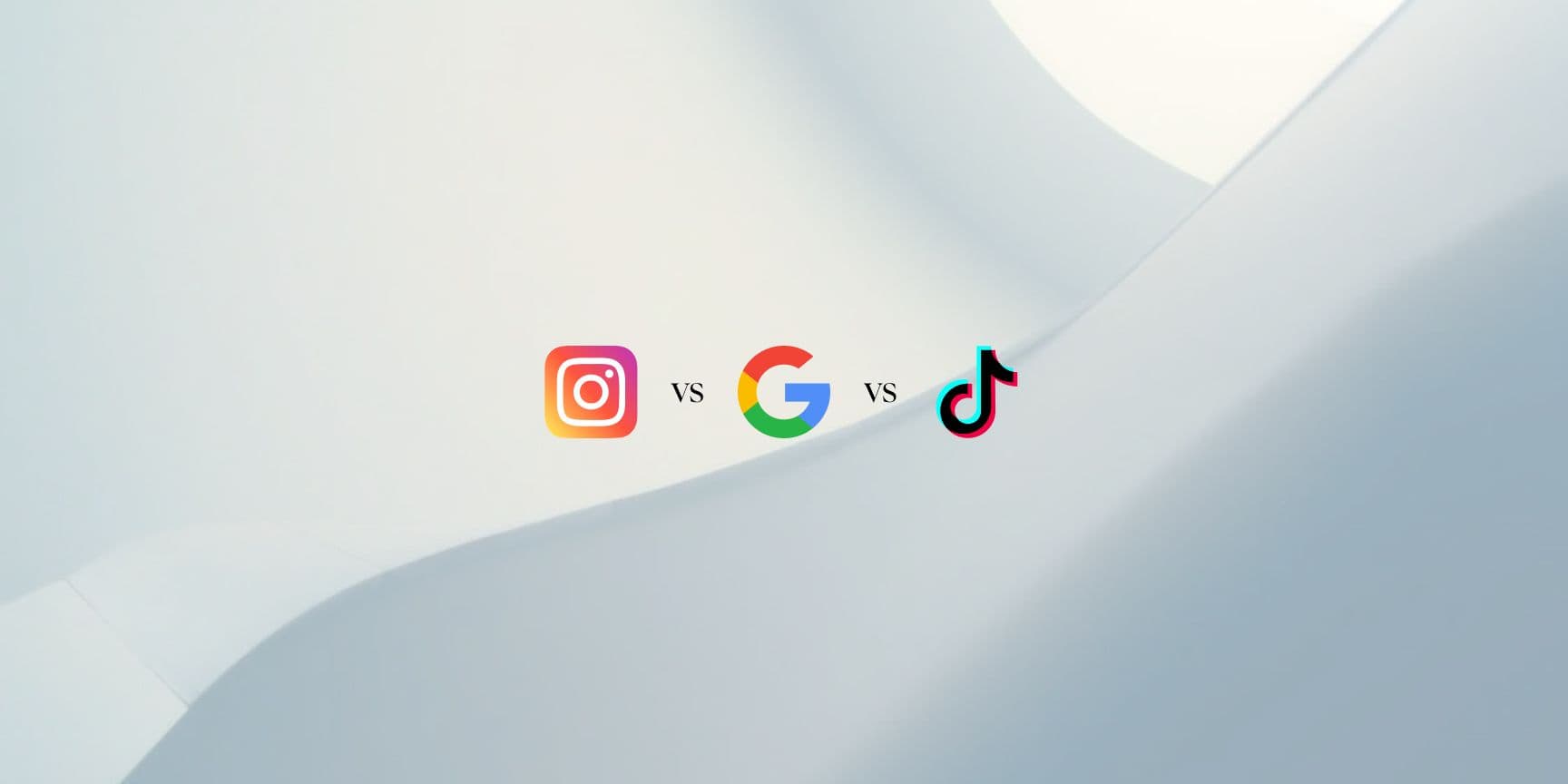Which channels should be used to address the new search behaviors of Internet users?

Social media Director

SEO & Analytics Director

Google, TikTok, Instagram: How can brands leverage the complementary strengths of these platforms to adapt their strategy?
A discussion featuring insights from Jonathan Gérôme, SEO Director, and Joffrey Martin, Social Media Director, on these new trends.
When selecting the best platform to achieve our clients' digital communication goals, it is essential not to oppose Google against social networks like TikTok or Instagram. Each of these platforms plays a specific role in an overall strategy, and it is their complementarity that maximizes the impact of your campaigns. This strategy is called “social SEO”.
Which platform do you prioritize for your clients depending on the topic: Google, TikTok, or Instagram?
Google: The Foundation of Detailed Search
Google remains the go-to search engine for obtaining precise and detailed information. To understand user needs and expectations, analyzing search volumes on Google is essential. It provides a solid foundation for understanding what users are actively searching for. As such, Google is particularly favored for topics requiring in-depth research, especially for informative, technical content and e-commerce. Integrating this data into an SEO strategy ensures strong visibility in search results.
TikTok and Instagram: The Power of Visual Engagement
On the other hand, TikTok and Instagram are gaining popularity for more visual and interactive searches, often related to trends. These platforms have become search engines in their own right for certain audiences, particularly younger generations.
Instagram has now become an essential giant, highly effective for reaching a wide audience. It is a consistent platform for many B2B and B2C brands, ideal for sharing various types of content such as tips, testimonials, user-generated content (UGC), or employer branding content.
TikTok, for its part, is becoming an increasingly popular playground for brands. However, this platform requires a creative approach that is adapted to its unique style. TikTok is particularly relevant for brands whose target audience is predominantly aged 18-25. However, it is crucial to assess whether the investment needed to succeed on TikTok is worthwhile, depending on the presence of the target audience on this platform.
Social SEO: A Strategy Built on the Alliance of Platforms
To offer our clients optimal visibility, it is crucial to integrate Google, TikTok, and Instagram into a coherent strategy. A thorough analysis of searches on Google, combined with social data monitoring on social networks, allows us to cover an exhaustive scope. This approach helps us capture the entire audience by adapting to the different behaviors of our targets. In summary, the effectiveness of a digital strategy relies on the complementarity of these tools, thereby ensuring optimal coverage of user expectations.
The choice of platform ultimately depends on the client's specific goals, their target audience, and the type of content they want to promote. By wisely combining these different tools, you can offer a truly comprehensive and effective SEO and digital communication strategy.
An in-depth analysis of Google searches combined with our open web monitoring solutions to capture social data and search data allows us to understand where our audiences are, what interests them, and what triggers their reactions.
Why does Generation Z prefer TikTok and Instagram over Google for their searches?
Although Google remains the most widely used search engine in the world, it is undeniable that Generation Z tends to diversify its search tools, particularly turning to platforms like TikTok and Instagram. This trend is well understood by these primarily visual platforms, which respond by offering short, interactive, and engaging formats.
Social media platforms are constantly evolving to offer more immersive experiences and increasingly numerous features. The goal is simple: to keep users on the platform for as long as possible by allowing them to do everything in one place—sharing content, consuming content, interacting with others, and conducting searches—thereby maximizing audience monetization.
This approach works very well with Gen Z for several reasons:
- The search experience is more fun and immersive, with dynamic and pragmatic content.
- User-Generated Content (UGC) has become so important that users can quickly find thousands of reviews on brands, products, or services. This community-driven and authentic aspect reassures Gen Z.
- The algorithms on TikTok and Instagram also provide a more personalized search experience, quickly delivering content that interests Gen Z both in terms of substance and form. Special mention goes to TikTok for educational content: TikTok, in particular, has become a platform where education and entertainment converge. Hashtags like #study and #exam202x are increasingly used.
Specific Advantages of Google, Instagram, and TikTok in 2024
Two Main Reasons Why Google is Strong Today and Essential for an Effective Strategy:
- Visibility
Google remains the most widely used search engine in the world, with a dominant market share. Its ability to offer massive visibility is unparalleled. For any business, being well-ranked on Google ensures access to a broad and diverse audience, covering all age groups, including Generation Z. This universal reach makes Google a central pillar of any digital marketing strategy. - Credibility and Reliability
Search results on Google are widely perceived as credible and reliable. Ranking at the top of search results not only boosts visibility but also enhances user trust. This translates into qualified traffic and higher conversion rates, making Google essential for brands looking to solidify their image and generate high-quality leads.
TikTok and Instagram: Reaching and Engaging a Younger Audience, enhancing Google’s Visibility.
Instagram: The Versatile Social Network King of Engagement
- Large Audience and Engagement Frequency
With 2 billion active users each month, Instagram ensures brands maintain regular connections with their audience. Traditionally, Instagram has excelled in boosting brand awareness and consideration through attractive visuals and consistent engagement. Although the platform was previously criticized for its limited direct conversion capabilities, recent developments as a social search engine have changed this. Today, Instagram meets all the criteria for optimizing social return on investment (Social ROI). - Optimized Search Experience
Instagram has also advanced by integrating more robust search features, addressing new user behaviors. This opens up opportunities for a more comprehensive digital strategy, where Instagram evolves from being a mere tool for brand awareness to becoming a key channel for brand discovery and conversion.
TikTok: Immersion and Authenticity
- Immersive User Experience
In just a few years, TikTok has become a major player with over 1.5 billion active users each month. The platform offers a deeply immersive and addictive user experience, reflected in an average daily usage time of 95 minutes, significantly higher than the 51 minutes observed on Instagram. This ability to capture and hold attention is one of TikTok's key strengths. - Authentic Audience Relationships
TikTok is distinguished by its ability to foster close and authentic relationships between brands and their consumers. The short-form content format, often focused on authenticity and creativity, allows businesses to connect more personally with their audience. For brands targeting a younger demographic, TikTok becomes an essential channel for building lasting relationships and effectively engaging their consumers.

In summary, while Google remains essential for in-depth searches, Generation Z is drawn to TikTok and Instagram for more immersive, authentic, and personalized experiences. These platforms answer to a growing demand for dynamic and community-driven interactions, making the search experience not only informative but also entertaining.
Brands aiming to capture the attention of this generation should therefore consider an active presence on these social networks, tailoring their content to the specifics and expectations of Gen Z.